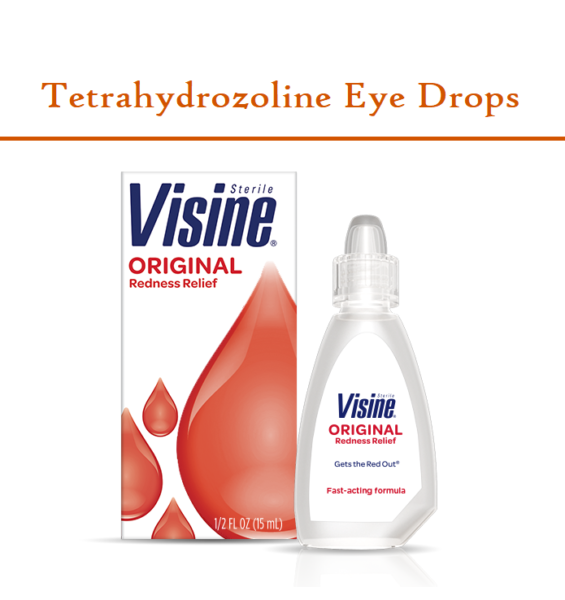Tetrahydrozoline is a medication primarily used as a decongestant for the eyes. It's commonly found in over-the-counter eye drops for relieving redness and irritation caused by minor eye irritants such as smoke, dust, and pollen. Tetrahydrozoline works by constricting blood vessels in the eyes, which reduces redness and swelling. However, it's essential to use it as directed and avoid prolonged use, as excessive use can lead to rebound redness and other side effects.
Tetrahydrozoline Eye Drops is a sympathomimetic drug that causes ocular arteriolar constriction. It is used to treat minor symptoms related to eye allergies.
Tetrahydrozoline eye drops uses:
- Ocular decongestant:
- It is used to relieve minor symptoms associated with ocular allergies such as redness of the eye, eye irritation, burning, and discomfort from dryness of the eyes as caused by exposure to sun and wind.
Tetrahydrozoline Eye Drops Dose in Adult
Tetrahydrozoline Eye Drops Dose as an ocular decongestant:
- When you're treating eye redness or irritation with tetrahydrozoline eye drops, you typically put 1 to 2 drops into the affected eye(s) up to four times a day. Just follow the instructions on the label or your doctor's advice to make sure you're using it correctly.
Tetrahydrozoline Eye Drops Dose in Children
Dose as an ocular decongestant (Visine products only):
- Children ≥6 years, and Adolescents:
- Ophthalmic: Refer to adult dosing.
Pregnancy Category: N (not assigned)
- Data are limited regarding its use in pregnancy and lactation.
- It should be used during pregnancy if the benefits outweigh the risks and unless advised by a healthcare provider, it should not be used.
Tetrahydrozoline Dose in Kidney Disease:
- The manufacturer's labeling typically doesn't provide specific dosage adjustments for tetrahydrozoline in individuals with renal impairment.
- This means that there are no special instructions or changes in dosage recommended for people with kidney problems.
Tetrahydrozoline Dose in Liver disease:
- The manufacturer's labeling for tetrahydrozoline usually doesn't include specific dosage adjustments for individuals with hepatic impairment, meaning there are no special instructions or changes in dosage recommended for people with liver problems.
Side effects of Tetrahydrozoline Eye Drops:
- Cardiovascular:
- Hypertension
- Palpitations
- Tachycardia
- Central Nervous System:
- Headache
- Transient Burning Or Stinging In The Eyes
- Neuromuscular & Skeletal:
- Tremor
- Ophthalmic:
- Blurred Vision
Contraindications to Tetrahydrozoline Eye Drops:
- Documentation regarding allergenic cross-reactivity for ophthalmic sympathomimetics is limited.
- However, due to similarities in chemical structure and/or pharmacologic actions, there's a possibility of cross-sensitivity.
- This means that while it's not fully confirmed, there's a chance that if someone is allergic to one ophthalmic sympathomimetic, they might also have an allergic reaction to others due to their similar properties.
Warnings and precautions
Cardiovascular disease
- Tetrahydrozoline, like other sympathomimetic drugs, should be used cautiously in patients with cardiovascular diseases, such as hypertension (high blood pressure) and coronary artery disease.
Diabetes:
- Using tetrahydrozoline in patients with diabetes should be approached with caution.
Glaucoma:
- Certainly. Tetrahydrozoline should be used cautiously in individuals with narrow-angle glaucoma.
Hyperthyroidism:
- Using tetrahydrozoline should be approached with caution in individuals with hyperthyroidism.
Monitoring Parameters:
None mentioned.
How to administer Tetrahydrozoline Eye Drops?
- For Ophthalmic Use Only: Only use these eye drops for your eyes.
- Wash Hands Before Use: Clean your hands thoroughly before applying the eye drops.
- Avoid Touching: Don't let the tip of the container touch any surface, your eyelids, or the area around your eyes.
- Remove Contact Lenses: Take out your contact lenses before using eye drops with benzalkonium chloride.
- Wait Before Reinserting Contacts: After using the drops, wait at least 10 minutes before putting your contacts back in.
- Don't Use If Eyes Are Red: If your eyes are still red after using the drops, avoid putting in your contacts.
Mechanism of action of Tetrahydrozoline Eye Drops:
- Tetrahydrozoline stimulates alpha-adrenergic receptors in the small blood vessels (arterioles) of the conjunctiva, the thin membrane covering the white part of the eye.
- This stimulation causes vasoconstriction, which means the blood vessels narrow or tighten.
- As a result, there's a reduction in blood flow to the conjunctiva, leading to decreased redness and inflammation in the eye.
International Brand Names of Tetrahydrozoline:
- Eye Drops
- GoodSense Eye Drops
- Opti-Clear
- Visine Advanced Relief
- Allersine
- Apiallerg
- Azoline
- Bano Ocular
- Berberil N
- Berberil-N
- Eye Clear
- Eye Relief
- Eye-Visol
- Insto
- Ivysine
- Murine Plus
- Murine Sore Eyes
- Oftan Starine
- Ophtal
- Optispring
- Optizoline
- Santo
- Stilla drops
- Tetzoline
- Tyzine
- Vasopos
- Visina
- Visine
- Visine Advanced
- Visine Advanced Relief
- Visine Classic
- Visine Clear
- Visine Original Eye Drops
- Vispring
- Visubril
Tetrahydrozoline Brand Names in Pakistan:
|
Tetrahydrozoline HCl Eye Drops 0.05 %w/v in Pakistan |
|
|
Octilia |
Neo Medix |







